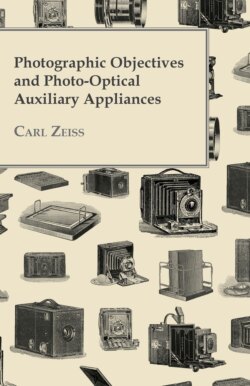Читать книгу Photographic Objectives And Photo-Optical Auxiliary Appliances - Carl Zeiss - Страница 9
На сайте Литреса книга снята с продажи.
Preface.
ОглавлениеTen years have passed since the appearance of our first Catalogue of Photographic Appliances in 1891. A comparison of that catalogue in its modest form with the present edition will demonstrate at a glance what a very decided advance in all branches of photography has taken place in that short space of time. Not only has photography gained a dominant position in the ever-expanding field of reproduction, but it has also become the favourite pastime of all classes of society and an important auxiliary to art and scientific research.
There can be no doubt that our objectives have given considerable impulse to this development, because they at last furnished a solution of the problem, which had been a stumbling block ever since photography was first invented, viz. the problem of how to combine rapidity with anastigmatic flatness of field.
The story of the development of our industry, from the wide-angle Anastigmats of 1890 to the birth of the Planar in 1897, is related in a work by Dr. M. von ROHR of Jena, which was published in 1899 under the title of “Theorie und Geschichte des photographischen Objectivs”; the year 1900 witnessed the advent of our latest novelty in the field of photographic optics, viz. the Unar.
In this space of little more than ten years the combined supply to all parts of the world by ourselves and our license-holders has reached a round total of
100000 Anastigmatic Objectives
and this fact ought to be sufficient proof of the high estimation in which our productions are held. We may be allowed to advance the opinion that the universal confidence extended to us is in a great measure due to our exact methods of execution, which enable us to give an absolute guarantee of the equally perfect condition of each instrument of any given class. Hence, every one of our customers has the positive assurance of being supplied by us exclusively with goods of the very highest grade.
In order that the name itself should suggest the characteristic features of our anastigmatic objectives, we adopted the descriptive designation of “Anastigmat”, a word which at the time in question was seldom used. But other makers soon applied the same name to objectives which neither in external appearance nor in their nature could bear comparison with our lenses, and this abuse created a dangerous state of confusion. To obviate the difficulty we decided in the course of the year 1900 to drop the name “Anastigmat” and to adopt instead the registered name of “Protar”. Following up the same principle, we also had the trade description for the new constructions already mentioned — the “Planar” and the “Unar” — registered as our exclusive property, so that these names cannot in future be applied to any but our own objectives.
The “Unar”, described in a supplement (published on April 1, 1900) to the 1899 edition of our catalogue, is remarkable for rapidity and simplicity of construction. On account of its universality of application it is eminently adapted for hand cameras and surpasses in excellence all objectives previously applied to this purpose.
In addition to the notice of this new production we would make the important announcement that by the employment of new kinds of glasses from the Glass Works of Messrs. SCHOTT # GENOSSEN of JENA, we have been enabled to construct anastigmatically well corrected objectives with reduced secondary spectrum. We flatter ourselves that we have therely rendered an important service to the reproduction branch of photography, and this opinion has received confirmation from the large number of letters of commendation received by us.
In conclusion, having received many urgent solicitations for light objective mounts, we have decided to supply our objectives in future, if specially so ordered, in mounts of a light alloy of aluminium. This metal, if not subjected to careless usage, offers a sufficient guarantee of durability, it diminishes the weight of an objective considerably, and will, no doubt, gain special favour as a material for mounting the objectives of hand cameras.
Jena, March 1901.
Carl Zeiss,
Section for Photography.
